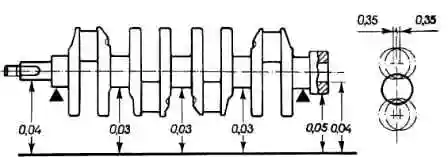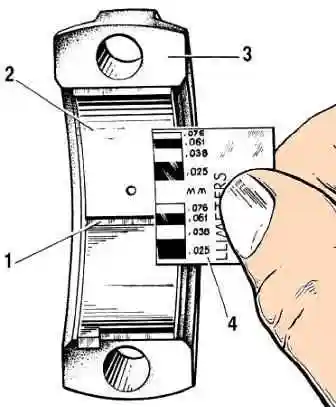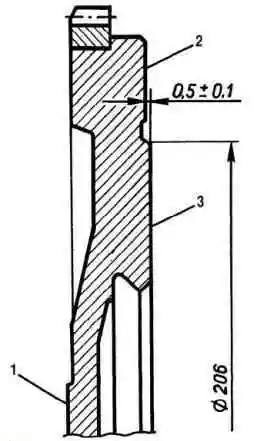The main dimensions of the crankshaft are given in Figure 1.
Crankshaft - cast, cast iron, five-bearing.
It is possible to regrind the crankshaft journals during repairs with a diameter reduction of 0.25; 0.5; 0.75; and 1 mm.
The axial movement of the crankshaft is limited by two thrust half rings.
They are inserted into the seats of the cylinder block on both sides of the middle main bearing, with a ceramic-metal semi-ring (yellow) placed on the back side, and steel-aluminum on the front side.
Half rings are made in two sizes - normal and increased in thickness by 0.127 mm.
Crankshaft bearing shells - thin-walled, steel-aluminum.
Upper bearings 1, 2, 4 and 5 of the crankshaft bearings have a groove on the inner surface, and the lower bearings are without a groove.
3rd leg bushings (upper and lower) without groove.
The connecting rod bearings (upper and lower) are also without a groove.
Repair liners are made of increased thickness under the crankshaft journals, reduced by 0.25; 0.5; 0.75 and 1 mm.
The flywheel is cast iron, cast, with a pressed steel gear rim for starting the engine with a starter.
The flywheel is centered by the front bearing of the gearbox input shaft, pressed into the crankshaft.
On the rear surface of the flywheel, near the gear rim, there is a mounting mark in the form of a conical hole.
It should be against the crankpin of the fourth cylinder.
Checking the technical condition and repair
Crankshaft
Inspect the crankshaft. Cracks anywhere on the crankshaft are not allowed.
On surfaces mating with the working edges of the seals, scratches, nicks and marks are not allowed.

Install the crankshaft with extreme main journals on two prisms (Figure 2) and check the runout with an indicator:
- - main journals (no more than 0.03 mm);
- - seating surfaces for the sprocket and bearing of the drive shaft of the gearbox (no more than 0.04 mm);
- - surfaces mating with the stuffing box (no more than 0.05 mm).
Measure the diameters of the main and connecting rod journals. The necks should be ground if their wear is more than 0.03 mm or the ovality of the necks is more than 0.03 mm, and also if there are scratches and marks on the necks.
Grind the necks with a reduction in diameter to the nearest repair size (see figure 1).
When grinding, keep the journal fillet dimensions similar to those shown in Figure 1 for normal crankshaft dimensions.
The ovality and taper of the main and connecting rod journals after grinding should be no more than 0.005 mm.
The displacement of the axes of the connecting rod journals from the plane passing through the axes of the connecting rod and main journals after grinding should be within 0.35 mm (see Figure 2).
To check, install the shaft with extreme main journals on prisms and set the shaft so that the axis of the connecting rod journal of the first cylinder is in a horizontal plane passing through the axes of the main journals.
Then, use an indicator to check the vertical displacement of the crankpins of the 2nd, 3rd and 4th cylinders relative to the crankpin of the 1st cylinder.
After grinding the necks, polish them with diamond paste or GOI paste.
After grinding and subsequent finishing of the necks, remove the plugs of the oil channels, and then process the sockets of the plugs with a cutter A.94016/10, put on the spindle A.94016.
Rinse the crankshaft and its passages thoroughly to remove abrasive residues and blow with compressed air.
Using drift A.86010, press in new plugs and score each at three points with a center punch.
On the first cheek of the crankshaft, mark the amount of reduction in the main and connecting rod journals (for example, K 0.25; W 0.50).
Inserts
No adjustments can be made on the inserts.
When scuffing, scratches, or peeling, replace the liners with new ones.

The gap between the liners and the crankshaft journals is checked by calculation (by measuring the details).
It is convenient to use a calibrated plastic wire to check the gap. At this In this case, the verification method is as follows:
- - carefully clean the working surfaces of the liners and the corresponding neck and place a piece of plastic wire on its surface;
- - install a connecting rod with a cap or a main bearing cap on the neck (depending on the type of neck being checked) and tighten the nuts or fastening bolts.
Tighten the nuts of the connecting rod bolts to a torque of 51 Nm (5.2 kgcm), and the bolts of the main bearing caps to a torque of 80.4 Nm (8.2 kgcm);
- - remove the cover and, using the scale printed on the package, determine the size of the gap by the flattening of the wire (Fig. 3).
The nominal design clearance is 0.02-0.07 mm for connecting rod journals and 0.026-0.073 mm for main journals.
If the gap is less than the limit (0.1 mm for connecting rod and 0.15 mm for main journals), then these liners can be used again.
If the gap is greater than the limit, replace the liners on these necks with new ones.
If the crankshaft journals are worn out and ground to a repair size, then replace the liners with repair ones (increased thickness).
Thrust half rings
As well as on inserts, no fitting operations can be performed on half rings.
In case of scuffing, risks or delaminations, replace the half rings with new ones.
Half rings are also replaced if the axial clearance of the crankshaft exceeds the maximum allowable - 0.35 mm.
For new half-rings, select a nominal thickness or increased by 0.127 mm to obtain an axial clearance in the range of 0.06-0.26 mm.
The axial clearance of the crankshaft is checked using an indicator, as described in the article "Engine Assembly".
The axial clearance of the crankshaft can also be checked on the engine installed on the vehicle.
In this case, the axial movement of the crankshaft is created by pressing and releasing the clutch pedal, and the gap is determined by the movement of the front end of the crankshaft.
Flywheel
Check the condition of the toothed rim and replace the flywheel if the teeth are damaged.
If the flywheel has tint on surface 3 (fig. 3), check the rim tightness on the flywheel.
The rim must not turn with a torque of 590 Nm (60 kgcm).

On surface 1 of the flywheel adjacent to the crankshaft flange, and on surface 3 under the clutch disc, scratches and scuffs are not allowed.
Remove scratches and scuffs on surface 3 with a groove, removing a layer of metal no more than 1 mm thick.
At the same time, also grind surface 2, keeping the size (0.5 ± 0.1) mm.
When turning, it is necessary to ensure the parallelism of surfaces 2 and 3 relative to surface 1. The non-parallelism tolerance is 0.1 mm.
1. Install the flywheel on the arbor, centering it on the mounting hole against surface 1, and check the runout of planes 2 and 3.
At the extreme points, the indicator should not show beats exceeding 0.1 mm.






